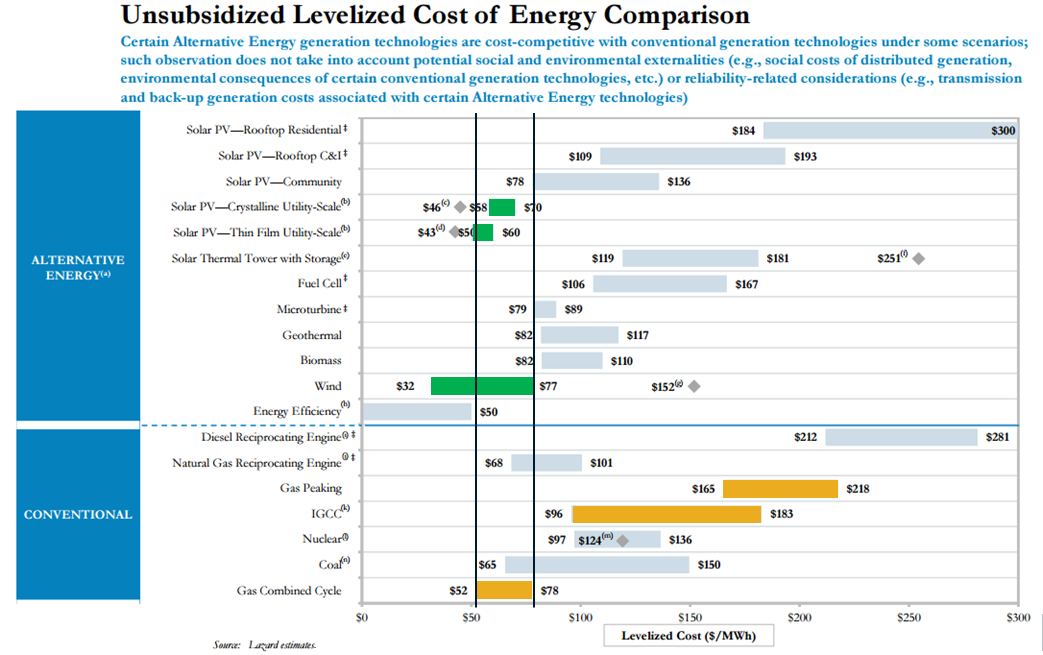New technology has tipping points—defined by functionality, consumer preference, and price. Clean energy is passing a huge one.
For years, the holy grail of clean electricity has been to make new solar or new wind cost-competitive with new coal or new natural gas. To compare prices of power technologies, economists use “levelized cost of energy,” or LCOE, which creates a net-present value of capital and operational expenditures of different technologies, and then amortizes them over 20 years of electricity production.
Lazard does this well:

What these estimates show, and what is now happening in the energy marketplace, is that new utility-scale solar and wind beat new fossil—and that is great where new power plants are being built. So it is not surprising the majority of new capacity installations in the U.S. for the past two years were wind and solar projects, as developers check the numbers and see these renewables projects beating out conventional energy technologies. But what about mature economies, where electricity demand is flattening as energy efficiency kicks in, and where the power of incumbency protects coal investments made forty years ago, but which still spin off cash?
Well, a new barrier has been crossed. It is now cheaper, in many parts of the country, to build a brand-new wind farm or solar plant than simply to pay the operating costs of coal, and sometimes even natural gas. That is the kind of tipping point worth paying attention to.
If a new wind farm in Colorado is cheaper than running old coal—and it finally is!—then there is money to be had and benefits to be shared. Lower electricity prices can be passed on to consumers. Some savings can be apportioned to coal miners or coal power plant staff for retirement or transition funds. Saved money can be used to pay off owners of old fossil plants. A newly proposed bill in Colorado would help make these opportunities a reality. The point is, we now have a clean energy revolution that can not only beat out old fossil, but can pay for much of the transition costs. That changes everything.
Economics (often) transcends ideology: You need not care about climate change or air pollution to want to save some money, or deliver those savings to your constituents or customers. Now we need to enable markets to promote clean energy.
Structurally, this entails rethinking the grid for high levels of renewables, but this is neither technically difficult, nor should it cost money. It does require changes to markets that were designed around large thermal units: Instead, markets must reward more flexible grid services. Utilities will need a new business model, so they can profit from energy services and reduced costs, rather than raw kilowatt-hour sales for capital cost recovery. We also need to get past the myths of the anti-renewables crowd: There is no reason that reliability need suffer as we add renewables to the grid, and wind and solar do not need vast sums spent to back them up, nor do they require miracles with batteries. There are extensive studies and experience to support these findings.
Still, even with technology and economics squarely on the side of clean energy, we have our work cut out for us. The most important challenges are to rethink the utility operations model, and to develop public policy so that institutions can prosper in this brave new world. It would be foolish, along this path, to ignore fossil’s deep incumbent power in politics, markets, and institutions. Nor can we overlook its enormous historical subsidies in technology development or its “leg up” in existing infrastructure and the free pollution of our air and atmosphere. Regulators need strategies to see that electricity markets fairly compensate renewables and that they intelligently, and rapidly, retire old fossil. They should share the benefits of these changes with displaced workers and their communities.
In other words, it is time to make some deals. There is clean energy, and cash, on the table. Let’s use them to accelerate this transition.
Hal Harvey’s Insights and Updates offers monthly thoughts and analysis on current energy and climate topics. These newsletters are written by Energy Innovation’s CEO Hal Harvey. Sign up here to receive Insights and Updates straight to your inbox.
